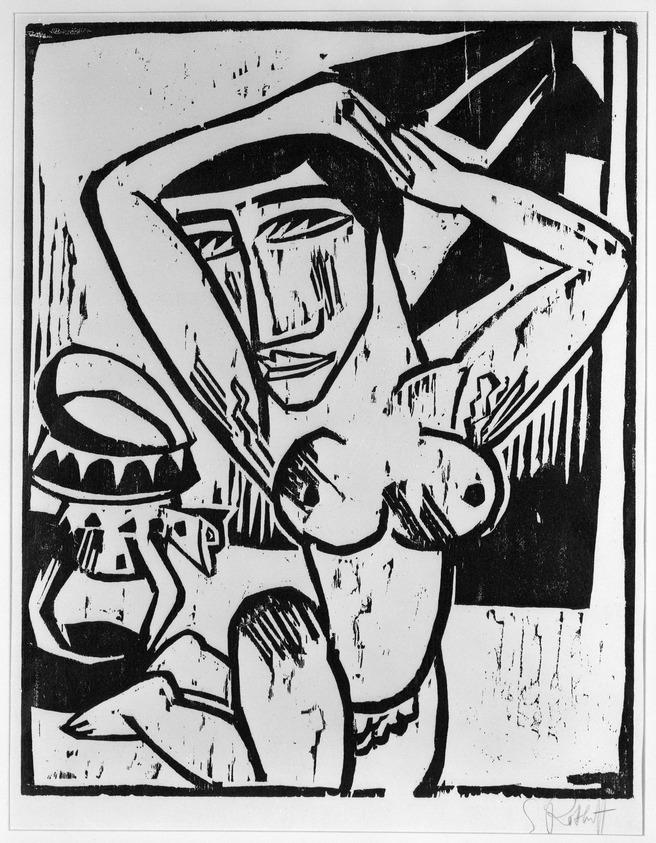Kneeling One (Kniende)
1 of 2
Object Label
Even as they sought to transform Western art, German Expressionists continued to engage with the conventional subject of the female nude. This figure’s angular, stylized forms and masklike face, and the stool from Cameroon beside her, reflect the fascination with non-Western art and culture among many modernist artists, and what they believed to be its authenticity and closeness to nature. Karl Schmidt-Rottluff specifically drew from Western and Central African sculptures, which were entering German ethnological museum collections in unprecedented numbers in the aftermath of colonial conquest.
In 1905 Schmidt-Rottluff cofounded the German avant-garde Expressionist movement Die Brücke (The Bridge) with Erich Heckel and Ernst Ludwig Kirchner, whose work can be seen nearby. Reflecting the radical break from naturalistic norms of traditional art, Die Brücke artists adopted a vocabulary of simplified or distorted forms and strong colors. Woodcuts, central to the group’s practice, account for well over half of the nearly seven hundred prints that Schmidt-Rottluff produced. The medium represented a cultural link between the group and earlier German artists such as Albrecht Dürer, and enabled its members to convey the physicality of carving and the textural qualities of wood with great immediacy and energy.
Caption
Karl Schmidt-Rottluff German, 1884–1976. Kneeling One (Kniende), 1914. Woodcut on laid paper, Image: 19 5/8 x 15 7/16 in. (49.8 x 39.2 cm) Sheet: 24 7/16 x 20 in. (62.1 x 50.8 cm). Brooklyn Museum, Frederick Loeser Fund, 51.150.2. © artist or artist's estate (Photo: Brooklyn Museum, CUR.51.150.2.jpg)
Gallery
Not on view
Collection
Gallery
Not on view
Collection
Artist
Title
Kneeling One (Kniende)
Date
1914
Medium
Woodcut on laid paper
Classification
Dimensions
Image: 19 5/8 x 15 7/16 in. (49.8 x 39.2 cm) Sheet: 24 7/16 x 20 in. (62.1 x 50.8 cm)
Signatures
Signed, "S. Rottluff" lower right margin in graphite
Inscriptions
"1292/11" (?) is inscribed in graphite near the lower left corner. There is a partially erased graphite inscription "38 S. ch." (?) near the lower right corner.
Credit Line
Frederick Loeser Fund
Accession Number
51.150.2
Rights
© artist or artist's estate
Copyright for this work may be controlled by the artist, the artist's estate, or other rights holders. A more detailed analysis of its rights history may, however, place it in the public domain. The Museum does not warrant that the use of this work will not infringe on the rights of third parties. It is your responsibility to determine and satisfy copyright or other use restrictions before copying, transmitting, or making other use of protected items beyond that allowed by "fair use," as such term is understood under the United States Copyright Act. For further information about copyright, we recommend resources at the United States Library of Congress, Cornell University, Copyright and Cultural Institutions: Guidelines for U.S. Libraries, Archives, and Museums, and Copyright Watch. For more information about the Museum's rights project, including how rights types are assigned, please see our blog posts on copyright. If you have any information regarding this work and rights to it, please contact copyright@brooklynmuseum.org.
Have information?
Have information about an artwork? Contact us at

